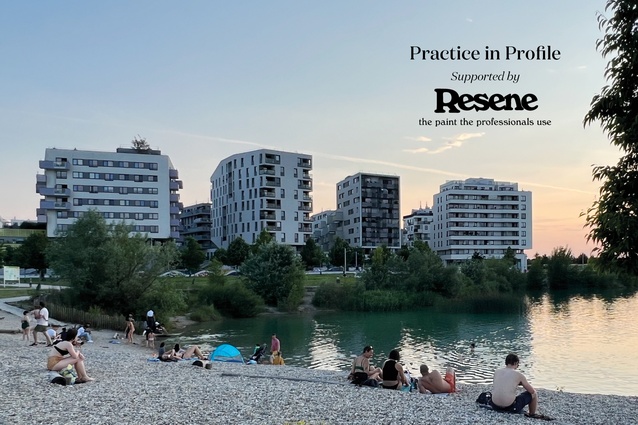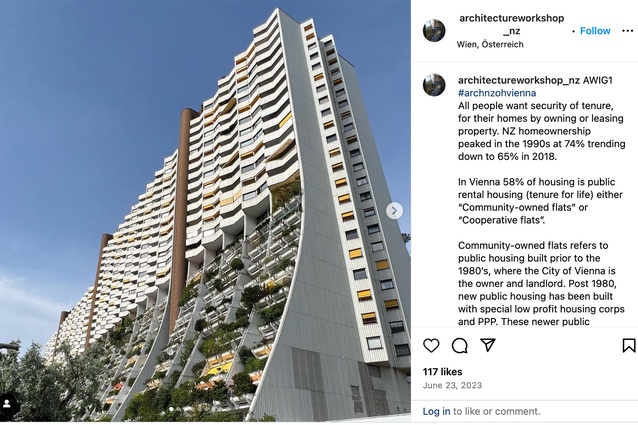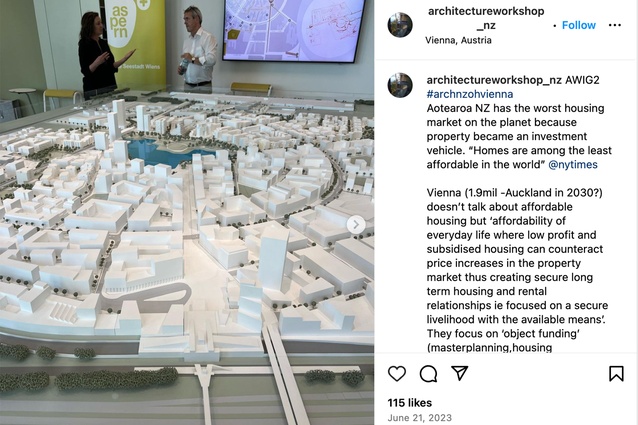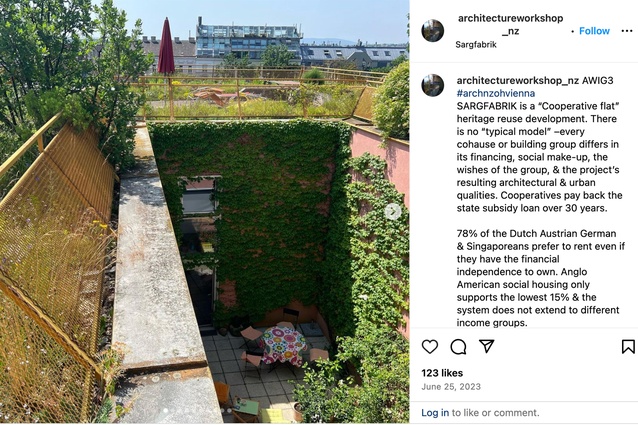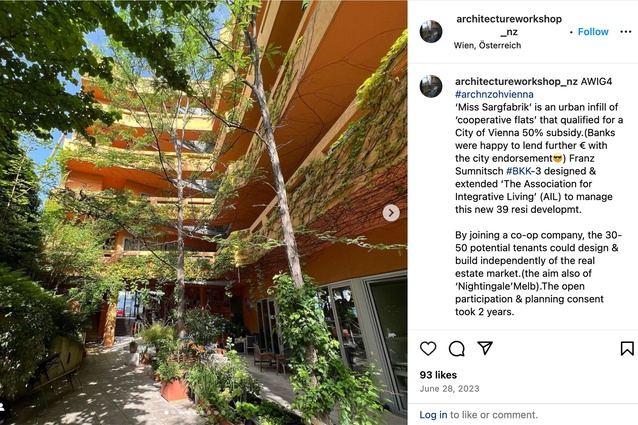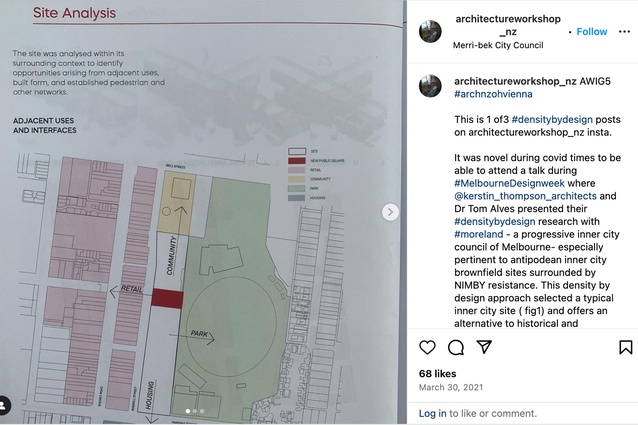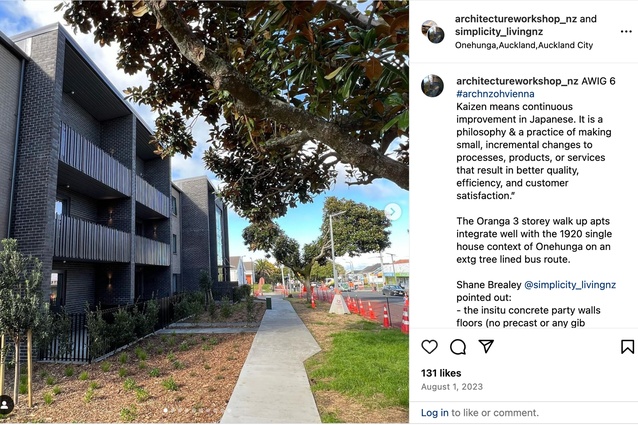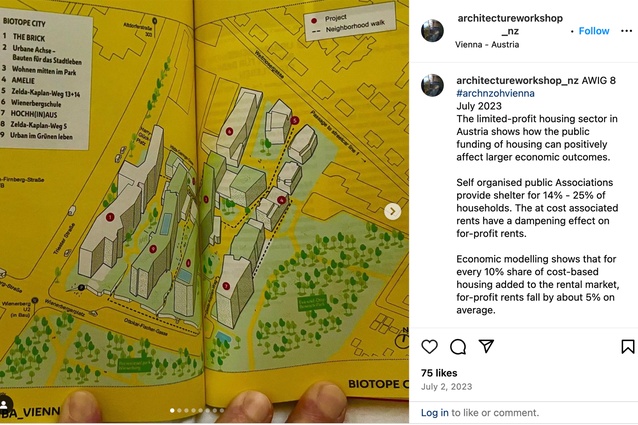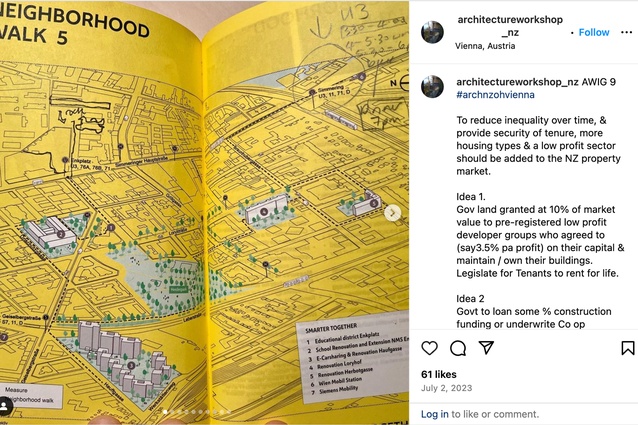‘Oh Vienna’ Where do we live tomorrow?
We’ve arrived at the present housing disaster rather like the Hemingway character explaining how he went bankrupt: “Two ways. Gradually and then suddenly.” Architecture Workshop’s Christopher Kelly examines Vienna’s ‘affordability of everyday life’ and recommends an amalgam of supply and demand-led housing solutions that New Zealand should pursue if we are at all serious about our egalitarian future.
After the collapse of the Austro-Hungarian Empire at the end of World War I, Austria became a republic. In 1919, Vienna held its first city council election and the left-wing Social Democratic Party won in a landslide. During the period of ‘Red Vienna’, the state enacted major housing reforms, funded by increased taxes on the wealthy. These buildings weren’t just utilitarian, they were grand, innovative structures, designed by some of the country’s most respected architects.1
“Building public housing with better living conditions than the dominant private market was a key ambition… ‘Paläste fūr die Arbeiter’, palaces for the workers,” explained Kurt Hofstetter, the International Building Exhibition coordinator with the City of Vienna (AWIG1). “World War II physically and economically damaged Vienna. However, the city’s commitment to social housing remained. From the 1950s to the 1970s, there was very high building activity in the public sector,” says Hofstetter. “Post-war, a federal tax was implemented where Austrians pay around one per cent of their income for social housing.”2
Two main types of social housing are offered. One is the city’s ‘public housing’, which is built, owned and operated by the City of Vienna. The other is tenant-initiated housing provided by ‘limited-profit co-op housing associations’.2 Since the 1980s, new public housing has been built with public-private partnerships and a special type of low-profit housing corporation (AWIG2).
In Vienna, the majority of housing (58 per cent) is in either of these two forms of public rental housing. For both types of public housing, it’s impossible to make a general statement about what a typical family pays in rent. For public housing and other housing assistance programmes in the United States, households pay exactly 30 per cent of their income, including utilities, on rent. However, for Viennese public housing, rent is not based on income but, instead, on the apartment unit: number of rooms, square metres, amenities and other factors.

Residents of Viennese public housing have a wide range of incomes. The focus is on housing for all rather than prescribing specific income ranges: e.g. to join a co-op, some tenants require a modest subsidy in the form of a low-interest, long-term government loan, which means the programme is scalable to actually produce enough housing to meet demand.
In both types of housing, social cohesion within the property and the surrounding neighbourhoods is a big consideration. Vienna (population 1.9 million – potentially Auckland’s population in 2030) doesn’t talk about affordable housing but “affordability of everyday life, where low-profit and subsidised housing can counteract price increases in the property market, thus creating secure, long-term housing and rental relationships, i.e. focused on a secure livelihood with the available means” (AWIG4). Less rent means more money to spend on socialising, eating and everything else.
These newer public housing rentals still draw from the City of Vienna’s pool of applicants for subsidised housing. Vienna does impose an income limit on new tenants of social housing but it is inclusive, allowing 75 per cent of the population to qualify, and it applies only at the beginning of each tenancy. If a household’s income increases, the inhabitants are not required to move and may even pass their apartment down to their children. The most important criteria is that “you have to prove a need for housing”. This can include “if you move out from home for the first time, if your contract expires or if you need an apartment that is more accessible”. In addition, residents need to have lived in Vienna for two years.
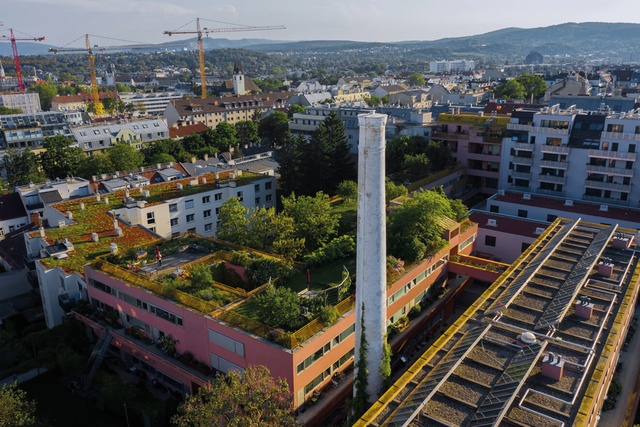
The housing agencies don’t build housing for just the poorest. The rents of each new project must cover its development and ongoing expenses. Accordingly, tenancies are mixed, so most tenants must earn regular income to pay those rents. Those with low incomes may receive rent subsidies. Lowest-income families – infirm, older people, students, single women – can be granted housing with a guaranteed rent at €7.5 per m2 (NZ$13.30m2) through an open-ended lease with no deposit.
Families may also join a cooperative association. This requires a deposit that secures a long-term tenancy and helps construct the apartment (AWIG2 and AWIG3). If less wealthy, people can apply for a low-interest loan from the government to raise the co-op deposit. It is repayable semi-annually over five, 10 or 20 years. This is paid in addition to regular rent.
Vienna has ensured affordable housing for all its residents by largely removing the profit motive from the housing system. Only 7.4 per cent of all housing stock in Vienna is for-profit and free of rent controls. The city doesn’t encourage Rent to Buy as it likes the assets to remain in the public portfolio. A major and very successful strategy of Vienna’s public housing programme is to create a surplus of public and rent-controlled private housing that exerts downward pressure on the unregulated private rental market.3
Earth hunger in the antipodes
Culturally, in both New Zealand and Australia, the 19th-century land boom after the gold rush reinforced the idea that land speculation is the basis for wealth creation. In 1887, Australian daily paper The Argus wrote: “Earth hunger has always distinguished the Anglo-Saxon race. And a piece of land, if judiciously bought, is acknowledged to be one of its safest investments.”4
In 1776, Adam Smith, the Scottish philosopher and father of classical economics, wrote An Inquiry into the Nature and Causes of the Wealth of Nations. It became widely accepted that: “In serving his own interests, the individual serves the public interest – he is guided to do so as though by an unseen hand. Better the unseen hand than the visible inept and predacious hand of the state.”
The great scholars of classical capitalism concerned themselves only with progress in the advanced European countries. Unconstrained capitalism in the colonies was something to be urged and was viewed as a progressive force.
“The idea that land was plentiful and easily obtained was established in the first few decades of the colony and the dream that everyone (except the original inhabitants of course) could acquire a quarter of an acre on which to build their castle,” wrote Smith.
Alan Kohler succinctly sums up: “So the treatment of land in New Zealand and Australia’s first century created conditions and attitudes that led to the housing crises of its third century.”4
Supply and inelastic demand
The law of supply and demand combines two fundamental economic principles describing the ways in which changes in the supply and/or demand of a resource, commodity or product affect its price. “If supply rises while demand stays constant or declines, the price will fall. Conversely, if supply constricts while demand stays constant or grows, the price will rise.”5
However, demand for basic necessities like housing is relatively inelastic, meaning it is less responsive to changes in price – as the price of the housing rises, consumers cannot easily shift to substitutes. (‘Inelastic’ means there are not many available alternatives). Consumers must also have the ability to pay for the shelter they need. Because the demand for housing cannot be controlled by price, then it follows that relying on the free-market mechanism to deliver housing is a fallacy. High prices do not reduce the demand; therefore, the ‘Adam Smith invisible hand’ driving the market cannot meet the demand for shelter without the intervention of a “predacious state”.
Australia recognised the limitations of the market after World War II by creating ‘The 1945 Commonwealth State Housing Agreement’ (CSHA) to provide federal funds to the states to ensure that every citizen had affordable access to a house. “We consider that a dwelling of good standard and equipment is not only the need but the right of every citizen, whether the dwelling is to be rented or purchased, no tenant of purchaser should be exploited by excessive profit.”4
The CSHA agreement was ended in 2003 – about the start of neoliberalism taking effect in Australia. In 1985, Aotearoa’s new Labour finance minister, Roger Douglas, embraced the principles of small government, balanced budgets and free market, neoliberal policies. These were a sharp departure from the postwar political consensus of interventionism, protectionism and full employment.
Two tribes
Philip Lowe, outgoing Governor of the Australian Reserve Bank, in September 2023 reiterates the choices available (and he might equally be talking about New Zealand):
“The reason that Australia has some of the highest housing prices in the world is the outcome of the choices we have made as a society: choices about where we live; how we design our cities; and zone and regulate urban land; how we invest in and design transport systems; and how we tax land and housing investment. In each of these areas, our society and politicians have made choices that lead to high urban land and housing costs. It is by tackling these issues that we can address the high cost of housing in Australia, obviously now a serious economic and social problem.”4
There are two political tribes in Australia (moderated by their Senate or, in New Zealand’s case, by MMP – well, until recently!) When it comes to thinking about solutions to unaffordable housing, “One tribe says the problem is tax breaks that boost demand too much (Labour) and the other says it’s zoning and planning that restrict supply (National/Liberal Coalition). Despite a succession of enquiries and reports about housing affordability, nothing has ever worked for long enough because it hasn’t been supported by national consensus. These two tribes can’t be reconciled,” writes Kohler.4
New Zealand’s 5.2 million people live in 2,018,100 dwellings, of which 65 per cent are privately owned – the lowest rate since 1951 – and 35 per cent are rented. Census data shows that home-ownership peaked in the 1990s at 74 per cent (Stats NZ, Sept 2018). Two-thirds of the population is, therefore, in favour of restricting the supply of houses to maintain the value of their own and they are supported in that by banks and developers. What are we trying to achieve and does anyone in power really want to achieve it?
“The price of housing is now twice the multiple of income it used to be 25 years ago. It was three to four times average annual earnings; now, it’s seven to eight times. Any serious effort to deal with housing affordability should be explicitly aimed at getting this ratio down and keeping it there,” says Kohler.4
The national New Zealand median house price is $790,000 (REINZ, Oct 2023). The current median household income is $114,920 per annum (Stats NZ, 2023). For the house-to-income ratio to be what it was, the median house price would have to halve. “More realistically, house prices could stay put for a while and allow incomes to catch up,” Kohler says.4
Annual wage growth in New Zealand averaged 2.14 per cent from 1993 until 2023 (Stats NZ, 2023). For the national median house price of $790,000 to maintain an affordability ratio of 3.5, the median household income would have to become $225,700 (which, multiplied by 3.5, is the median house price of $790,000).
At the average New Zealand wage growth of 2.1 per cent, house prices would have to stay where they are now for 28 years to allow incomes to catch up. (Australia, with a higher average wage growth per year of 4 per cent, contributed to by stronger union lobbying, would have to ensure that house prices stay where they are for only 18 years).
Theoretically, this is achievable if there were enough supply to meet demand. Both demand and supply sides of the equation must be pressed into service (not just by one of the two tribes).4

Both individual and collective
Margaret Thatcher’s conservative New Right Neoliberalism, from 1980 to 1990 in the UK, was heavily influenced by Prof. Friedrich Hayek, an Austrian/British Nobel Prize-winning economist from Vienna. The Austrian School of Economics had sought to understand the economy by examining the social ramifications of individual choice, an approach called Methodological Individualism. It differed from other schools of economic thought, which focused on equilibrium analysis and societal groups rather than individuals.6
Thatcher controversially interpreted this Austrian orthodoxy in an interview for Woman’s Own in September 1987, when she said: “Who is society? There is no such thing! There are individual men and women and there are families, and no government can do anything except through people and people look to themselves first. It is our personal duty to look after ourselves and then also to help look after our neighbour and life is a reciprocal business”.
Dame Anne Salmond recently argued, in reaction to the actions of the new right-wing coalition in New Zealand, that: “European ways of thinking summarised as ‘binary opposites’ are based on analytic logic dating from the 16th century. Relational logic works differently.
Rather than grids and hierarchies, for instance, relational logic orders the world into dynamic networks, animated by reciprocal exchanges – very like whakapapa.”7
“Not surprisingly, given the ubiquity of relational thinking in te reo, Te Tiriti o Waitangi is neither ‘individualist’ nor ‘collectivist,’ but a kin-based combination of both, based on manaakitanga – giving mana to others will encourage mutual respect and reciprocal exchanges – tuku atu, tuku mai,” says Salmond.
This inclusionary thinking is in marked contrast to the divisive, populist political ‘culture wars’ that anoint the class of ‘little capitalist’ property owners as innately superior to ‘welfare bludger’ renters.
Around 75 per cent of the Viennese population qualify as renters. Despite periods of neoliberal government in Vienna over recent decades, there has been no mass sell-off of social housing stock or a reversion of Rent to Buy to convert ‘renters’ into property owners. The city runs a balanced budget and owns enough housing (about 70 per cent) to control the rents and, hence, dampen the speculative market value of property. This benefits both tribes and, more critically, reduces the extremes of inequality over the longer term.
Supply and demand solutions to provide more housing
Given two-thirds of the population is interested in maintaining the value of their own property and that political tribes fight to reverse each other’s good policy, our first solution is to establish a bipartisan open-mindedness to address New Zealand’s housing mess, which is even more acute than Australia’s.
To diversify the housing supply for Aotearoa’s 10th century of human habitation, we will need generosity and kinship, a combination of old left- and right-wing solutions and to utilise every possible economic supply/demand lever listed below, as well as some we haven’t even thought of. The solutions are not ranked in any particular order. If we are serious about social cohesion, we need to action all of them.

Four pillars to strive for
What can architects contribute, given that, in over 98 per cent of the globe, we are not required and then, often, our inputs are seen as actually increasing inequality? The Wien Municipality points the way. Architects need to master knowledge about all of the ‘four pillars’ equally: Social sustainability, Economy, Ecology and Architecture.
Social sustainability: We need to be louder about social sustainability and learn more about ‘social value as a factor in the valuation of the built environment’. First of all, architects could learn how to record the data and present the social value that we do add.8 GIS technologies will make it easier to show where social value is being created and to use feedback from ‘open data map platforms’ for evidence-based urban design (AWIG5).
Economy: Architects can gain deeper knowledge about the financial drivers and risks in project development to help innovate and manage the cost to the public purse (AWIG9). We can add master-planning typology expertise at the first project feasibility stage, i.e. the ‘top down’ expertise, as well as expand our consultative skills to gather ‘bottom up’ data about community participation. An emphasis on repetitive, ‘non-bespoke’ typologies and better understanding of developer processes is essential.
The six architects who designed and developed the widely praised Nightingale Village in Melbourne developed a healthy respect for the skills developers bring to a project – once they had to provide them. Nightingale Projects now has a development manager to work alongside the architects.
Simplicity Living director Shane Brealey applies the Japanese business philosophy of ‘Kaizen’, searching, along with all employees, to improve design and delivery operations continuously (AWIG6).
Ecology: This involves understanding the ways in which communities are planned, by benchmarking with good-quality historical precedents. Resilience, and embodied and operational carbon should be considered as part of a larger, holistic world view that focuses on interconnections, as in te ao Māori (AWIG8). “If there’s any power in architecture, it’s the power of synthesis, when you identify all the forces at play, often pulling in opposite directions but you’re still able to understand the priorities” (Alejandro Aravena).18
Architecture: As always, we should look for solutions that do more than just one thing (AWIG5). We need to focus more on what architecture does and the relationships it creates rather than fetishise the object. Architects are building communities and cultures as much as places or systems.
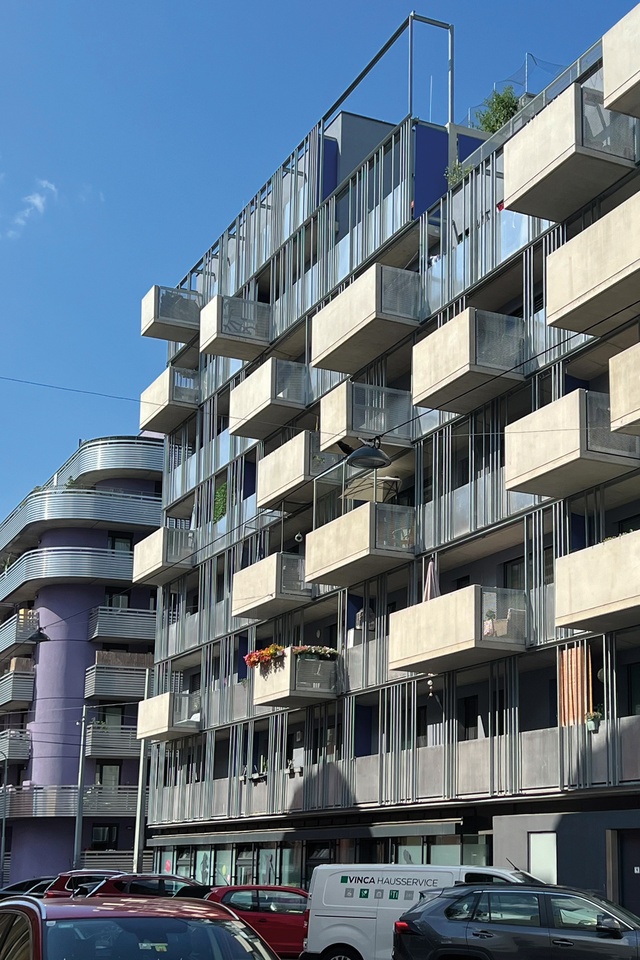
Supply-side solutions
Expand inward – better planning within existing cities. Argue for continual refinement of legislation.9 Utilise data that explores a ‘digital twin’ planning option. Contain unsustainable sprawl.16 Target middle-ring development (AWIG5). Seventy per cent of cities are residential. Recent census statistics for Melbourne show that, between 2001 and 2023, dwelling supply increased by 30 per cent (Peter Mares, Inside Story).10
- Housing at the periphery grew 50 per cent (unsustainable/expensive infrastructure, destroys soil/farmland, socially detrimental in longer term) 15
- Housing in the inner ring grew 13 per cent (consolidate urban blocks, increase diversity housing and non-profit typologies, re-evaluate heritage restraints)
- Households in the central city grew 100 per cent – doubled to 103,000 dwellings (continue brownfield, reuse old, develop to increase walkable city density).
Incentivise local councils
Provide government incentive payments to councils to encourage better planning and property administration policies (AWIG5).
Currently, the Australian Government “allocates $15,000 per dwelling, capped at $3 billion over five years”4 – not nearly enough! Simon Kuestenmacher (@simongerman600) suggests a stick rather than a carrot approach that gives every council a quota of medium-density housing approvals – if the councillors don’t meet the target, then monies are deducted. If they don’t meet quota for two years in a row, then councillors are sacked!)
Advocate vociferously: #QualityInMyBackyard Use our democracy to advocate for fairness. Generate consensus instead of manufacturing phoney culture wars. Focus on facts and keep asking how we will live tomorrow. YIMBY groups in Australia have formed ‘the abundant housing network’ and made submissions on a range of broad-brush ideas that include:4
- Consult the wider community before beginning
- Move from prescriptive land rules to outcomes-based regulation
- Change zoning over broad areas not only specific sites
- Remove car-parking requirements, e.g. Nightingale
- Investigate efficient and equitable consolidation of urban blocks and smaller suburban sections
- Facilitate density in high-amenity, walkable areas with public transport and social infrastructure.
Support low-profit, self-organised co-op housing
Provide some state underwriting and/or lease land to reduce land cost for the ‘ethical housing movement’: e.g. Assemble Communities, with its ‘build-to-rent’ approach, Nightingale developments, and iwi developments on Māori and collectively owned land. Expand the NZ Simplicity Living KiwiSaver model. Subsidise low-profit co-ops as per the Vienna model.3
Wien Municipality grants public land at 10 per cent market value and loans construction money at low rates (paid back over 30 years) to pre-registered, low-profit developer groups who agree to a low (say, 3.5 per cent per annum) profit on their capital and maintain/own the building for life and if the co-op opts to comply with the legislated Social Housing Rules concerning operation, reselling, etc.11
Co-housing participants develop the brief together and make a deposit to buy the land/get planning permission for a right to rent for life. There is no ‘typical model’ – every cohaus or building group project differs in its financing, its social make-up, the wishes and desires of the group, and the project’s resulting architectural and urban qualities (AWIG4). Often, the largest challenge for groups is to organise the loan quickly enough to secure the site. To make this beneficial co-op-housing type more attractive, governments could legislate to allow payment on a site to be deferred for say three months until planning consent is gained.

Expand the diversity of housing types
“Co-op housing ops offer vital stability all the way through to old age and retirement because it can’t be used as an investment vehicle”.12 The state should allocate 10 per cent of housing funding targeting commercially developed co-op housing to make up a tenth of housing stock by 2033.
As in Vienna, the public purse is kept replenished by the continuing cycle of loan repayments, much like a low-profit version of the big banks (AWIG8).
Currently, the Business Council of Co-operatives and Mutuals (BCCM) says roughly one per cent of all housing in Australia is co-op housing, initiated by developer/builders, so there are few case studies to assess. Wellington exemplars dating from the 1960s are still in good use: for instance, ‘Gateways’ at 19 Maida Vale Road, the 54 two-bedroom-apartment block owned by individuals who ‘purchase’ company shares (very similar to the ‘Andelsboliger’ model in Denmark). The elected body corp or association controls the title mortgage for the property and has responsibility for maintaining and insuring the property. Banks are very picky about extending a mortgage if a buyer has less than a 50–60 per cent deposit; this makes it more difficult for younger buyers. Lobby for change to diversify the housing market (AWIG9).
Adopt a long-term plan to renovate old housing stock
Use public money to renovate private housing stock that then accepts permanent rent control. In the 1980s, Vienna City, seeking to expand its pool of rent-controlled housing further, began a programme to use public money to rehabilitate 10,000 old, decaying private houses per year. Landlords had been unwilling to make the upgrades for decades and, eventually, the private sector accepted rent controls introduced with the public investment in the building upgrades. By law, now, any private housing built before 1945 is subject to rent controls.
Extend PT infrastructure to strengthen regional growth
Provide better and faster public transport (PT) to extend the one-hour commute zone and emphasise growth in multiple regional towns. The essence of the problem of affordability is that land further than 50km from the city is cheaper only before the high cost of infrastructure and the social cost of suburban isolation without nearby jobs is taken into account (AWIG7). Significantly increasing density within 10–30km of CBDs is less difficult in the long term.9
Although, economist Shamubeel Eaqub cautions,13 solutions that work well in Holland/Europe may not transfer to New Zealand – geography and population density make transport and other infrastructure considerations quite difficult.
Emphasise the importance of long-term planning rather than endlessly expanding one big city. Establish regional growth centres that already have reasonable urban amenities, well connected to the national public transport network: for instance, Tauranga, Whakātane, Tūrangi, Whanganui, Masterton, Timaru, Cromwell and Invercargill.
Commit to a yearly provision of public/social housing
The hand-wringing about the housing crisis, the claims that “it’s complicated” and that “there’s no silver bullet”, and the broad resignation of not having a solution are all forms of public policy crime. Become more radical about holding all governments to account.15 The state should NEVER reduce the public housing estate – instead, it could find innovative ways to improve the return cashflow from public-funded projects and utilise public venture capital.17
Vienna uses minimal new taxpayer funds to subsidise housing construction. The city’s housing fund was seeded in the first half of the 20th century and is self-sustaining because it gives loans, not grants, which are repaid and recycled to produce new housing. In addition, ‘limited profit housing associations’ (LPHAs), which must use their profits to build more housing, control half of the city’s social housing (AWIG3).
In the new Quartier Am Seebogen, the state focuses on ‘object funding’ (master-planning and housing infrastructure and construction), using non-anonymous developer competitions (AWIG2). The developer owns and maintains the building. Qualifying developers can purchase the land for 10 per cent of market rate. Here is the crux, though – small improvements from the previous development and innovation is mandatory. The developer/architect team bids are evaluated against ‘four pillars’, equally weighted: social sustainability, economy, ecology and architecture.14
Demand-side solutions
Balance immigration with demand
The second action on demand should be to link immigration to the capacity of the New Zealand construction industry; net overseas immigration would be kept at roughly two to two-and-a-half times the number of housing approvals. Immigration policy should not simply be driven by business demand for low-cost labour. There also needs to be a clear assessment of our national need for longer-term population growth.4
Remove taxes that distort demand
Immediately halt the tax system distorting demand by limiting negative gearing to newly built houses and use a simple formula to adjust the capital gain for inflation before taxing it at the marginal income tax rate (as it was in Australia between 1985 and 1999).4 “If you want less of something, tax it more, and if you want more of something, you tax it less.”17

Christopher Kelly is currently mulling over ways, specific to Aotearoa, that architects can contribute to a culture of place, and how we might more effectively communicate architecture and city thinking beyond our profession (RMIT University practice research). Kelly divides his time between Australia, providing architecture input to selected projects in the KTA studio, and Architecture Workshop in Aotearoa. Instagram account architectureworkshop_nz
References:
1 openheritage.eu/wp-content/uploads/2018/11/3_OpenHeritage_Vienna_observatory-case.pdf
2 sargfabrik.at
3 P van der Putt & O Klijn, 2013, ‘Miss SargfabrikWenen/Vienna’, BKK DASH | Delft Architectural Studies on Housing (08), pp. 116–123.
4 Alan Kohler, 2023, The Great Divide: Australia’s housing mess and how to fix it. Quarterly Essay, Issue 92.

5 investopedia.com
6 theconversation.com/why-theres-no-such-thing-as-society-should-not-be-regarded-with-moral-revulsion-136008
7 newsroom.co.nz/2023/12/15/anne-salmond-on-the-treaty-debate-maori-and-pakeha-think-differently/
8 Dr Flora Samuel, ‘Why architects matter… Social value toolkit for architecture’, Cambridge Uni, UIA Lecture 2023. constructioninnovationhub.org.uk/our-projects-and-impact/value-toolkit/
9 Dr Eric Crampton, Chief Economist at the New Zealand Initiative, ‘The Housing Theory of Everything’.
10 Peter Mares, 2018, ‘No place like home’, Inside Story. insidestory.org.au/authors/peter-mares
11 John Kenneth Galbraith, 1977, The Age of Uncertainty. BBC, Andre Deutsch Ltd.
12 Business Council of Co-operatives and Mutuals (BCCM), October 2023, New+Generation+Housing+Cooperatives+Report+(231031).pdf, propertycollectives.com.au, cohousingaustralia.au
13 bwb.co.nz/books/generation-rent/
14 ‘City Guide, Where do we live tomorrow?’, IBA WIEN New Social Housing, 2022.
15 Gareth Hutchens, abc.net.au/news/2024-03-24/tax-land-properly-27-billion-in-tax-revenue-prosper-australia/103623806
16 Rachel Clun, ‘The missing middle that could help fix Australia’s housing crisis’, The Age, Sat 6 Jan 2024
17 Prof. Mariana Mazzucato, 2022, Mission Economy: A moonshot guide to changing capitalism, Penguin
18 Alejandro Aravena, interview by Masoud Golsorkhi. tank.tv/magazine/issue-97/features/masoud-golsorkhi-alejandro-aravena
Instagram references:
The author’s Instagram posts are cited within this article as: AWIG1 Alterlaa/ AWIG2 Seebogan/ AWIG3 Sargfabrik/ AWIG4 Miss Sargfabrik/ AWIG5 Density by design/ AWIG6 Simplicity Living/ AWIG7 Land cost/ AWIG8 Biotope IBA/ AWIG9 SmartCity IBA. These posts can be found by searching ‘#archnzohvienna’ on Instagram.


